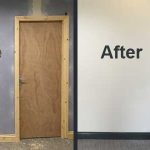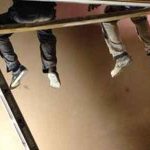The construction process involves a lot of planning and timing. It will involve many different trades and they have to work together in a specific order, to ensure that the job is run efficiently and correctly.
As a result, building work is completed in stages. This is the case, whether you are working on a new build, or renovating an existing property. There are several different trades that will work before and after one another, and this includes plastering and plumbing.
The general rule is to complete all first fix plumbing before any plastering takes place. This is also true for other trades, such as electricians, who will also carry out first fix before the plasterers come in.
Once the first fix is finished, all the plastering related work will be completed. Following this, the plumbers and other trades will return to start completing all the second fix work.
What is involved in first fix plumbing?
First fix plumbing is essentially all the work that will be hidden following plastering and second fix. The work will involve:
- Running all pipework for water
- Pipework and drainage to remove wastewater from the property
- Pipe work for central heating and radiators
Much of this pipework will run under floorboards, in stud walls and fixed to masonry walls. The vast majority of this, will be hidden by the plasterers.
The work that plumbers carry out during the first fix, can be messy and disruptive. Therefore, it is especially important this work is carried out before plastering. This will help to avoid delays and disruption, allowing the plasterers to carry out all their work without other trades under their feet.
Plastering work between first and second fix plumbing
With the first fix complete, the plastering can begin. The work will vary based on the type of job and the surfaces being plastered.
Plastering Existing Walls
If a property is being renovated, then it is likely that some of the walls are made of brick or blockwork. If this is the case, the plasterer will need to carry out initial prep work to make the walls ready for plastering
Where existing walls consist of brick or blockwork, the plasterer will need to ensure they are prepared correctly. If they are using a backing plaster, this will be applied directly to brick and blockwork. If the walls are uneven, this will also help to create a smooth undercoat for skimming. Bricks and blockwork are porous, so the plasterer may need to apply a coat of dilute PVA, or plain water, to help reduce suction prior to application.
Installing Dot and Dab
Another option is to install plasterboards with dot and dab adhesive. The plasterer will apply dots of adhesive at intervals of 6 to 8 inches. Following this, the plasterboards are fitted on top, covering any first fix plumbing and electric work. Once the adhesive has dried, the walls can then be given a skim coat of plaster.
Boarding Studwork and Ceilings
If studwork has been installed, the plasterer will need to board the walls. The plasterboard will be cut to size and fixed directly to the studwork using drywall screws. Stud walls tend to be an area where pipes and wires are run during first fix, so most of this will be hidden by the plasterers when boarding.
Plasterboard’s will also be fitted to ceilings if required. This is done in the same way, with slightly longer drywall screws. These will be fixed directly into the ceiling joists.
Following all the initial work, applying backing coats and boarding, the plasterers will skim everything, to provide a clean, neat finish, ready for all the second fix work to commence.
What is involved in second fix plumbing?
After the plastering is complete, the second fix plumbing can take place. At this point, the plumber will carry out all internal work and will connect appliances where necessary. Second fix work is one of the main factors that make a property habitable, so it is an important part of the process.
During the second fix, the plumber will:
- Connect all pipework to the boiler
- Install radiators
- Connecting all plumbing in the bathrooms such as the toilet, bath, shower, and sink
- All work in the kitchen, such as sinks, taps and any other kitchen appliances.
Essentially, they will finish any work carried out during first fix that is related to water and also gas (providing they are gas safe)
Once this is all done, they will carry out final checks and test of all plumbing work to ensure there are no issues.
Conclusion
Whatever job you are working on, it’s important that all trades are used at the right time. The process happens in stages and where plumbing and plastering is involved, the two have to be finished in the correct order.
By following the correct stages, the work will be finished quickly, and each trade will be able to work efficiently without working on top of each other. It will also ensure that all jobs are done correctly, and no work needs redoing.




